fuel AUDI TT COUPE 2017 Owners Manual
[x] Cancel search | Manufacturer: AUDI, Model Year: 2017, Model line: TT COUPE, Model: AUDI TT COUPE 2017Pages: 322, PDF Size: 79.73 MB
Page 6 of 322
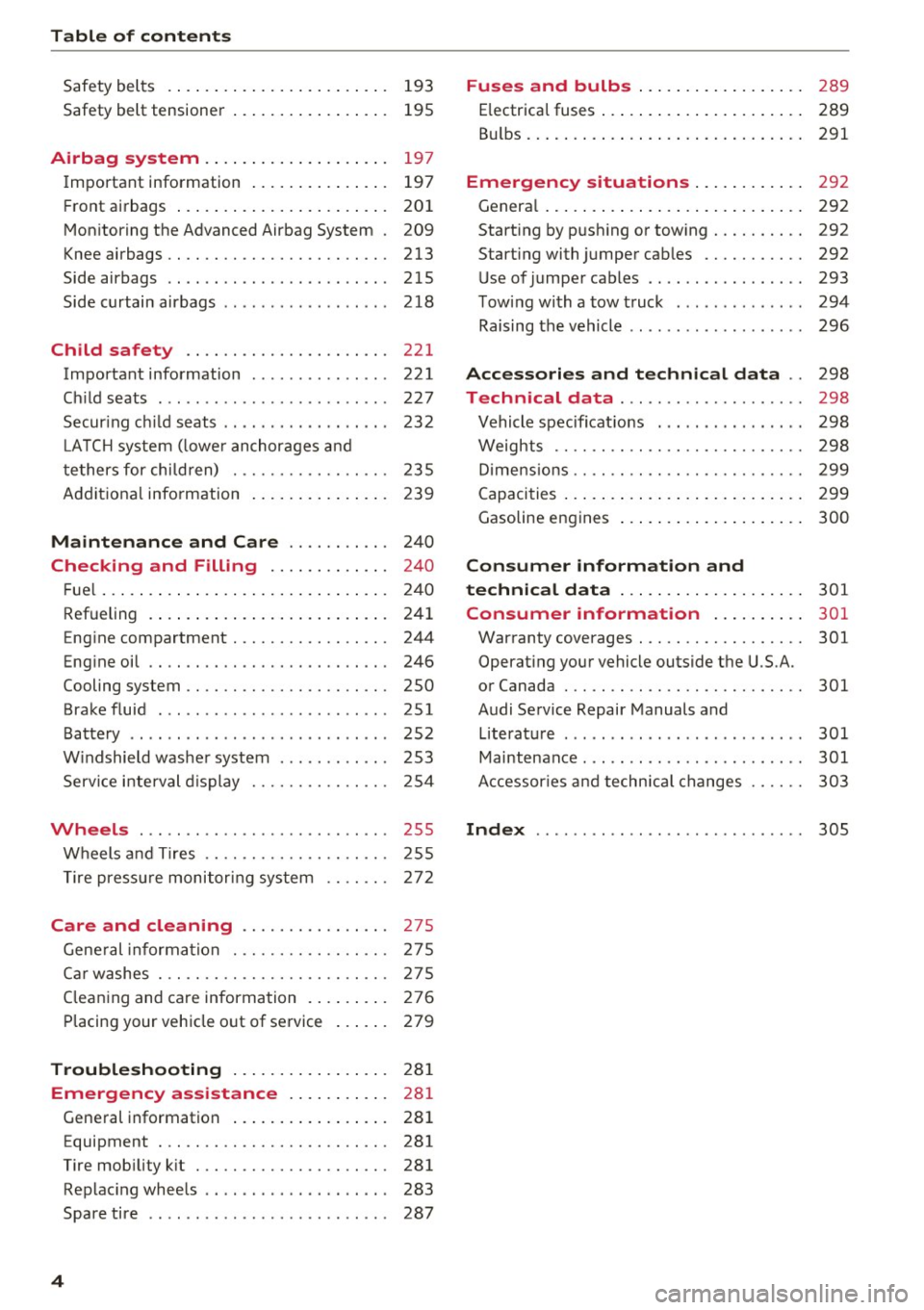
Table of content s
Safety belts . . . . . . . . . . . . . . . . . . . . . . . . 193
Safety belt tensione r . . . . . . . . . . . . . . . . . 195
Airbag system ... . ...... ... .. .. ... 19 7
I mportant info rmation . . . . . . . . . . . . . . . 197
F ront airbags . . . . . . . . . . . . . . . . . . . . . . . 201
Mon itoring the Advanced Airbag System . 209
Knee airbags .. .. ................. ... 213
Side airbags . . . . . . . . . . . . . . . . . . . . . . . . 215
Side curtain airbags . . . . . . . . . . . . . . . . . . 218
Child safety . . . . . . . . . . . . . . . . . . . . . . 221
Important information . . . . . . . . . . . . . . . 221
Ch ild seats . . . . . . . . . . . . . . . . . . . . . . . . . 227
Secur ing ch ild seats . . . . . . . . . . . . . . . . . . 232
L A TCH system (lowe r an chorages a nd
t e thers for chi ldren) . . . . . . . . . . . . . . . . . 235
Addit ional info rmation . . . . . . . . . . . . . . . 239
Maintenance and Care . . . . . . . . . . . 24 0
Checking and Filling . . . . . . . . . . . . . 240
F ue l. .. .. .... .. ... .. ..... ... .. .. ... 24 0
Refueling . . . . . . . . . . . . . . . . . . . . . . . . . . 241
E ng ine compartment . . . . . . . . . . . . . . . . . 244
Eng ine oil . . . . . . . . . . . . . . . . . . . . . . . . . . 246
Cooling system . . . . . . . . . . . . . . . . . . . . . . 250
Brake f luid . .. .. ..... ........... ... . 251
Batte ry . . . . . . . . . . . . . . . . . . . . . . . . . . . . 252
W indshield washe r system . . . . . . . . . . . . 253
Service i nterval d isplay 254
Wheels ... .... .......... ...... ... . 255
Wheels a nd Tires . . . . . . . . . . . . . . . . . . . . 255
T ire press ure monitor ing sys tem 272
Care and cleaning . . . . . . . . . . . . . . . . 275
Gene ral information . . . . . . . . . . . . . . . . . 275
C ar washes . .. .. ............. .... .. . 275
Clean ing and care information . . . . . . . . . 276
P lacing your vehicle out of service . . . . . . 279
Troubleshooting . . . . . . . . . . . . . . . . . 28 1
Emergency assistance . . . . . . . . . . . 281
Gene ral information . . . . . . . . . . . . . . . . . 281
E quipment . . . . . . . . . . . . . . . . . . . . . . . . . 281
Tire mob ility k it . . . . . . . . . . . . . . . . . . . . . 281
Replac ing whee ls . . . . . . . . . . . . . . . . . . . . 283
Spare ti re . . . . . . . . . . . . . . . . . . . . . . . . . . 287
4
Fuses and bulbs . . . . . . . . . . . . . . . . . . 289
E lectrica l fuses . . . . . . . . . . . . . . . . . . . . . . 289
Bu lbs .. ... .. .. .. .. .. .. . ... .... ... .. 291
Emergency situations . . . . . . . . . . . . 292
Genera l . . . . . . . . . . . . . . . . . . . . . . . . . . . . 292
Start ing by push ing or tow ing . . . . . . . . . . 292
Start ing with jumper cables . . . . . . . . . . . 292
Use o f jumper cables . . . . . . . . . . . . . . . . . 293
T owing with a tow truck . . . . . . . . . . . . . . 294
Raising the vehicle . . . . . . . . . . . . . . . . . . . 296
Accessories and technical data . . 298
Technical data . . . . . . . . . . . . . . . . . . . . 298
Vehicle spec ificat ions . . . . . . . . . . . . . . . . 298
Weights . . . . . . . . . . . . . . . . . . . . . . . . . . . 298
D imens ions. . . . . . . . . . . . . . . . . . . . . . . . . 299
Capaci ties . . . . . . . . . . . . . . . . . . . . . . . . . . 299
Gasoline engines . . . . . . . . . . . . . . . . . . . . 300
Consumer information and
technical data . . . . . . . . . . . . . . . . . . . .
301
Consumer information . . . . . . . . . . 301
Warranty coverages . . . . . . . . . . . . . . . . . . 301
Operat ing your vehicle outside the U .S.A.
or Canada . . . . . . . . . . . . . . . . . . . . . . . . . . 301
Audi Se rvice Repair Manuals and
Lite rat ure . . . . . . . . . . . . . . . . . . . . . . . . . . 301
Maintenance. .. .. .. .. ... ... .... ... .. 301
Accessor ies a nd techn ica l changes . . . . . . 303
Index .......... ... ............. ... 305
Page 10 of 322
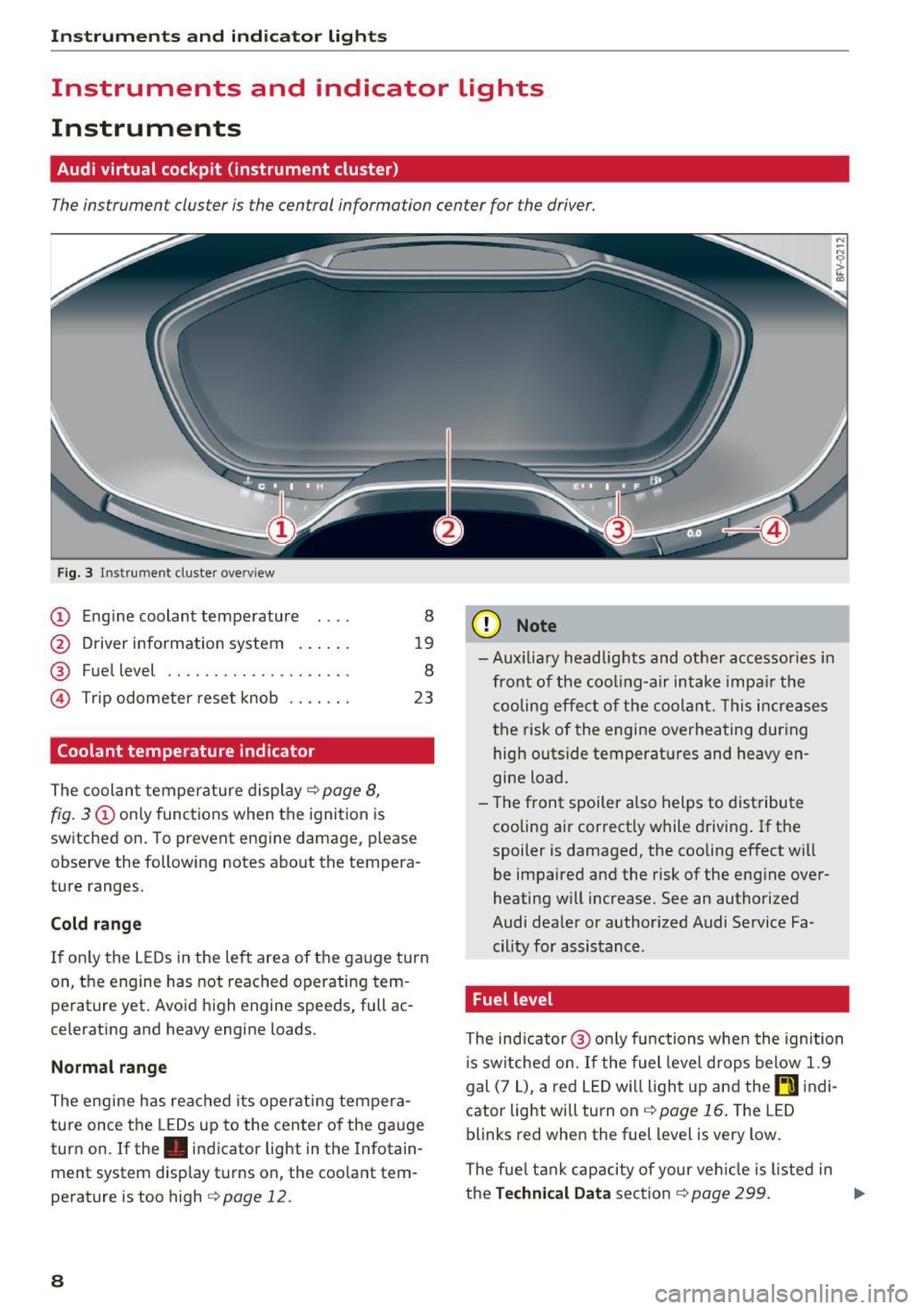
Instrumen ts and ind icator ligh ts
Instruments and indicator Lights
Instruments
Audi virtual cockpit (instrument cluster)
The instrument cluster is the central information center for the driver.
Fig. 3 Instrume nt cluster overv iew
(D Eng ine coolant temperature 8
@ Driver information system . . . . . . 19
® Fuel level . . . . . . . . . . . . . . . . . . . . 8
@ Trip odometer reset knob . . . . . . . 23
Coolant temperature indicator
The coolan t temperature display c:> page 8,
fig. 3
(D only functions when the ignition is
switched on. To prevent engine damage, p lease
observe the following notes about the tempera
ture ranges.
Cold rang e
If o nly the L EDs in the left area of the gauge turn
on, the engine has not reached operating tem
perature yet. Avoid high engine speeds, full ac
celerating and heavy engine loads .
Normal range
The engine has reached its operating tempera
ture once the LEDs up to the center of the gauge
turn on . If the . indicator light in the Infotain
ment system display turns on, the coolant tem
perature is too high
c:> page 12.
8
(D Note
-Aux iliary head lights and other accessories in
front of the coo ling-a ir intake impa ir the
cooling effect o f the coolant. This increases
the risk of the engine overheating during high outside temperatures and heavy en
gine load.
- T he front spoiler a lso helps to distribute
cooling air correctly while driving . If the
spoiler is damaged, the cooling effect will
be impaired and the risk of the eng ine over
heating w ill increase. See an authorized
Audi dealer or author ized Audi Service Fa
cility for assistance .
Fuel level
The indicator @ only func tions when the ignition
i s sw itched on. If the fuel level drops below 1.9
gal (7
L), a red LED wi ll light up and the rD indi
cator light will turn on
c:> page 16 . The LED
blinks red when the fuel level is very low.
The fuel tank capacity of your veh icle is listed in
the
Techni cal Dat a sectio n c:> page 299. ..,_
Page 11 of 322
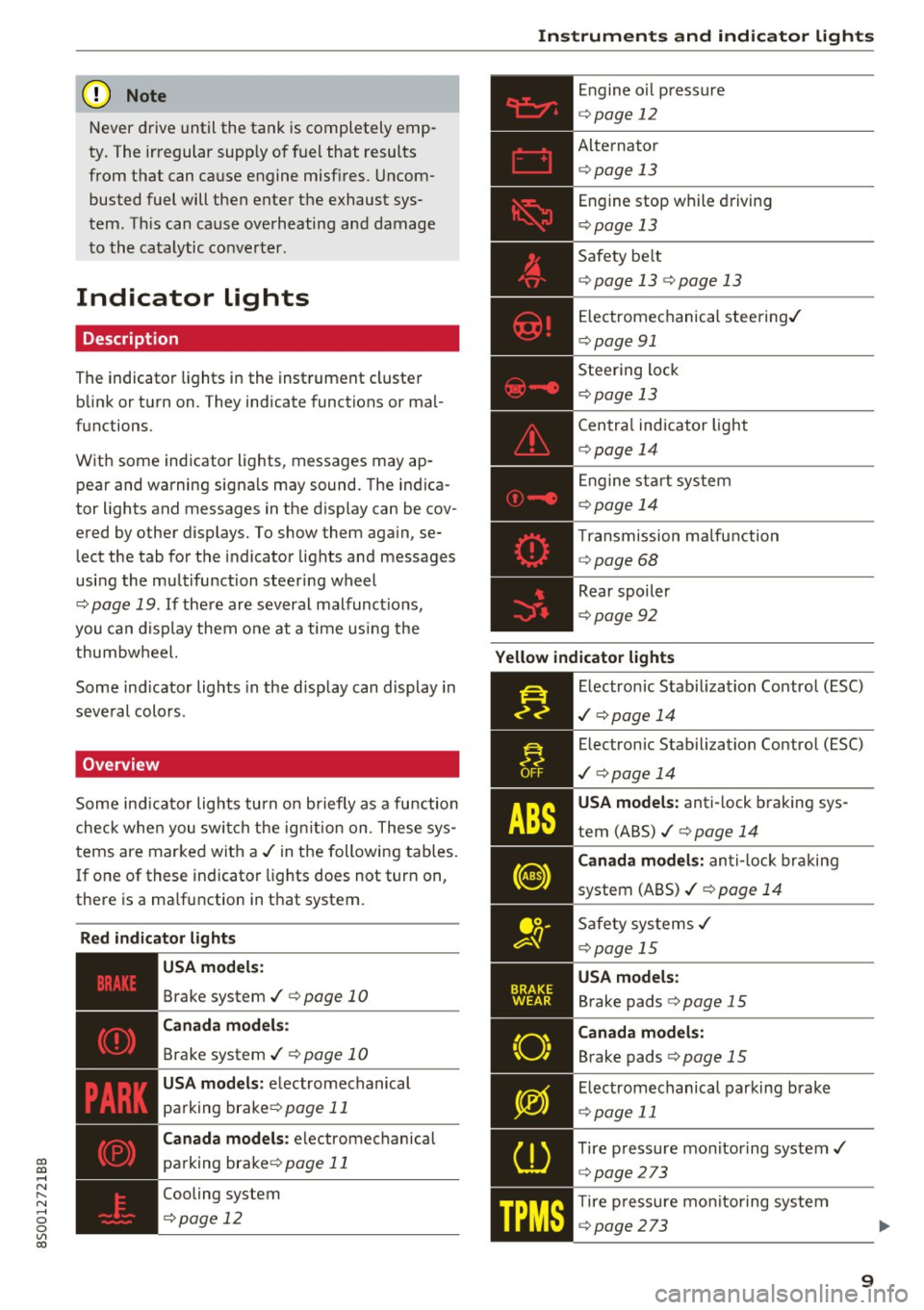
co
co
.... N
" N .... 0
0
Vl c:o
(D Note
Never drive until the tank is completely emp
ty. The irregular supply of fuel that results
from that can cause engine misfires . Uncom
busted fuel will then enter the exhaust sys
tem. This can cause overheating and damage
to the catalytic converter .
Indicator lights
Description
The indicator lights in the instrument cluster
blink or turn on. They indicate functions or mal
functions.
With some indicator lights, messages may appear and warning signals may sound. The indica
tor lights and messages in the display can be cov
ered by other displays. To show them again, se lect the tab for the indicator lights and messages
using the multifunction steering wheel
c;, page 19. If there are several malfunct ions,
you can display them one at a time using the
thumbwheel.
Some ind icator lights in the display can display in
several colors .
Overview
Some indicator lights turn on briefly as a function
check whe n you switch the ign ition on . These sys
tems are marked with a
,I in the following tables.
If one of these indicator lights does not turn on,
there is a ma lfunction in that system.
Red indicator lights
---------------
US A models :
Brake system ./ c;, page 10
Canada models:
Brake system ./ c;, page 10
USA models : electromechanical
parking brake¢
page 11
Canada models: electromechanical
parking brake¢
page 11
Cooling system
<=>page 12
Instruments and indicator lights
Engine oil pressure
c;,page 12
Alternator
¢ page 13
Engine stop while driving
¢page 13
Safety be lt
c;, page 13 c;, page 13
Electromechanical steering./
c;,page 91
Steering lock
¢page 13
Central indicator light
c;,page 14
Engine start system
c;,page 14
Transmission malfunction
c;, page 68
Rear spoiler
c;,page 92
Yellow indicator lights
Electronic Stabilization Contro l (ESC)
,I c;, page 14
Electronic Stabilization Control (ESC)
./ c;, page 14
USA models: anti-lock braking sys
tem (ABS)./
c;, page 14
Canada models: anti-lock braking
system (ABS) ./
c;, page 14
Safety systems ,I
c;,page 15
USA models:
Brake pads c;, page 15
Canada models:
Brake pads c;, page 15
Electromechanical parking brake
c;,page 11
Tire pressure monitoring system../
<=>page 273
Tire pressure monitoring system
<=>page 273
9
Page 15 of 322
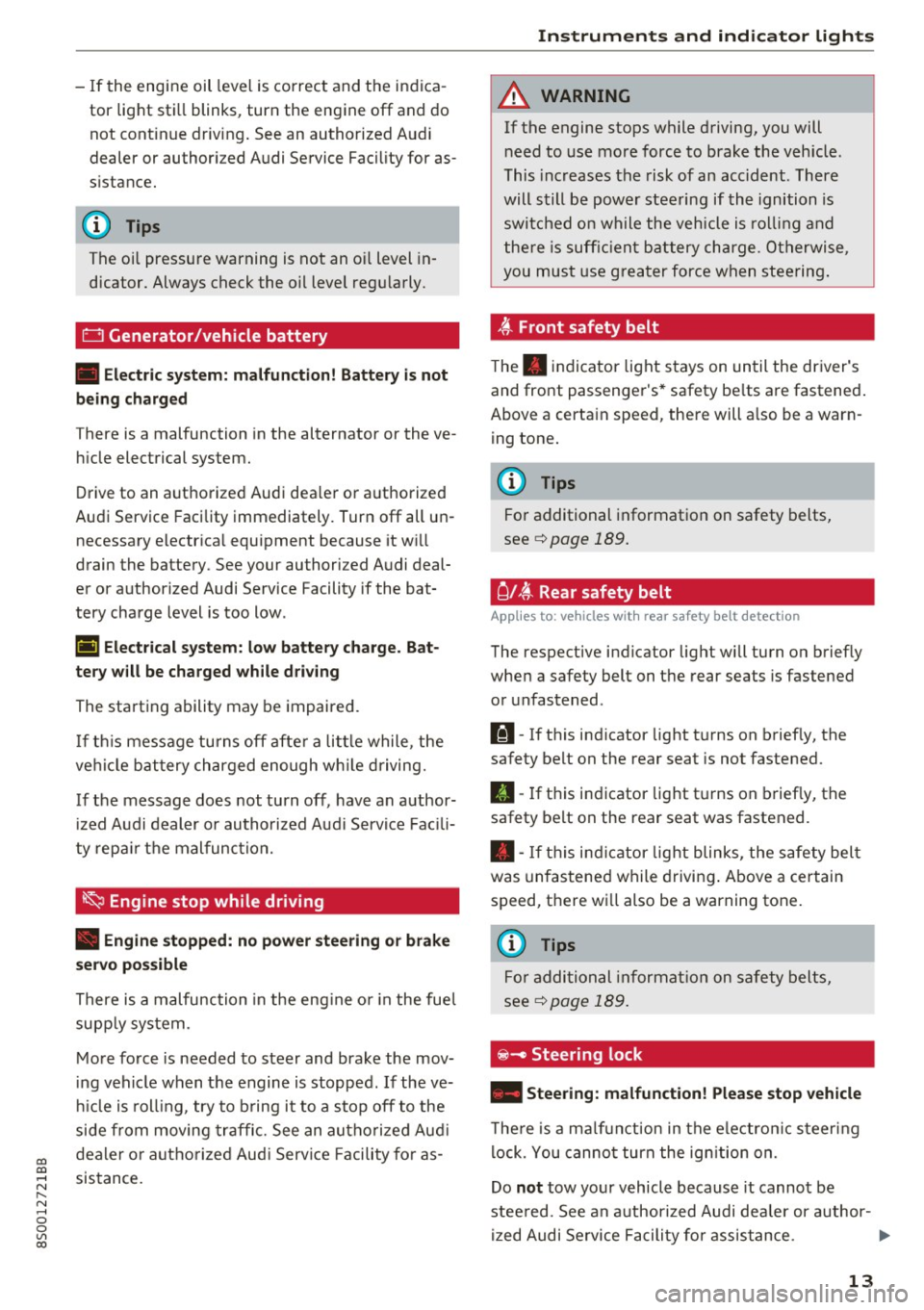
co
co
.... N
" N .... 0
0
Vl c:o
-If the engine oil level is correct and the indica
tor light still blinks , turn the engine off and do
not continue driving. See an authorized Audi
dealer or authori zed Audi Service Facility for as
sistance.
The oil pressure warning is not an oil level in
dicator. Always check the oil level regularly.
0 Generator/vehicle battery
• Electric system: malfunction! Battery is not
being charged
T here is a malfunction in the alternator or the ve
hicle electrical system.
Drive to an authorized Audi dealer or authorized
Audi Service Facility immediately. Turn off all un
necessary electrical equipment because it will
drain the battery . See your authori zed Audi deal
er or authorized Audi Service Facility if the bat
tery charge level is too low .
(•) Electrical system: low battery charge. Bat·
tery will be charged while driving
The starting ability may be impaired.
If this message turns off after a little while , the
vehicle battery charged enough while driving.
If the message does not turn off, have an author
ized Audi dealer or authorized Audi Service Facili
ty repair the malfunction.
~ Engine stop while driving
• Engine stopped: no power steering or brake
servo possible
There is a malfunction in the engine or in the fuel
supply system .
More force is needed to steer and brake the mov
ing vehicle when the engine is stopped. If the ve
hicle is rolling , try to bring it to a stop off to the
side from moving traffic. See an authorized Audi
dealer or authorized Audi Service Facility for as
sistance .
Instruments and indicator lights
A WARNING
-
If the engine stops while driving, you will
need to use more force to brake the vehicle .
This increases the risk of an accident . There
will still be power steering if the ignition is
switched on while the vehicle is rolling and
there is sufficient battery charge. Otherwise,
you must use greater force when steering.
~ Front safety belt
The. indicator light stays on until the driver's
and front passenger's* safety belts are fastened.
Above a certain speed, there will also be a warn ing tone.
@ Tips
For additional information on safety belts,
see
c::> page 189.
C l~ Rear safety belt
Applies to : vehicles with rear safety belt detection
The respective indicator light will turn on briefly
when a safety belt on the rear seats is fastened
or unfastened .
111-If this indicator light turns on briefly, the
safety belt on the rear seat is not fastened.
II-If this indicator light turns on briefly, the
safety belt on the rear seat was fastened.
• -If this indicator light blinks, the safety belt
was unfastened while driving. Above a certain
speed, there will also be a warning tone .
(D Tips
For additional information on safety belts,
see
¢page 189.
~ - Steer ing lock
• Steering: malfunction! Please stop vehicle
There is a malfunction in the electronic steering
lock. You cannot turn the ignition on.
Do
not tow your vehicle because it cannot be
steered. See an authorized Audi dealer or author-
ized Audi Service Facility for assistance.
1111>
13
Page 18 of 322

Instruments and indicator lights
'1=1";.. Engine oil sensor
• Oil level sy stem : malfunction! Plea se con
tact S ervic e
The senso r to check the engine oil level has
fa iled. Drive to an au thorized Aud i dea le r or a u
thor ized Audi Se rvice Facil ity immediate ly to have
the ma lfun ction co rrected.
II O il l ev el sen sor : oil chang e nece ssar y. Plea se
con tact Service
The engine oil leve l is too high.
Drive to an a uthorized Audi dea ler or authorized
Aud i Serv ice Facility immediately to have the
malfunct ion corrected.
CJ) Note
Refer to the description in the Owner's Man
ual ¢
page 248, Checking the engine oil level
and adding engine oil.
Bl Tank system
00] Pl ea se refuel
If the indicator lig ht turns on for the first time
and the message appears, there are about 1.9
ga l (7 L) of fue l left in the tank.
D Plea se refuel immediately
If the ind icator lig ht turns on the message ap
pea rs, the fue l tank is almos t empty. Refuel the
veh icle immed iate ly.
D Tan k system : ma lfun ction! Plea se contact
Servic e
If the indicator light turns on and th is message
appears, there is a malfunction in the tank sys
tem.
Drive to an authorized Aud i dealer or authorized
Aud i Serv ice Facility immediately to have the
malfunct io n corrected.
@ For the sake of the environment
Fuel should never enter the sewer system or
come into contact w ith the ground.
16
(D Tips
More information on refueling is available on
page ¢
page 241 .
~ Washer fluid level
m Please add washe r fluid
Fill the washer fluid for the windshie ld washer
system and the headlight washer system* when
the ignit ion is switched off¢
page 253.
conta ct Se rvice
There is a ma lfunction with the windsh ield wip
ers .
Drive to an authorized A udi dealer or authorized
Audi Service Facility immediate ly to have the
malfunction corrected .
. ·:
If the II ind icator light turns on, a bulb has
failed. The message indicates the location of the
bulb .
Replace the bulb immediately.
Vehicle light s: malfunction! Please contact
Ser vice
There is a m alfu nction in the headlights or the
li gh t sw itch. Dr ive to an a uthor ized Audi dealer or
a uth orized Aud i Serv ice Facili ty immedia tely to
have the malfunction cor rected.
_& WARNING
- Light bulbs a re under p ressure and can ex
plode when b ulbs are replaced, wh ic h in
creases the risk of injury .
- With gas -discharge lamps* (xenon head
lights), the high-vo ltage component must
be handled appropriately. Otherw ise, there
is a risk of fatal injury .
Page 20 of 322
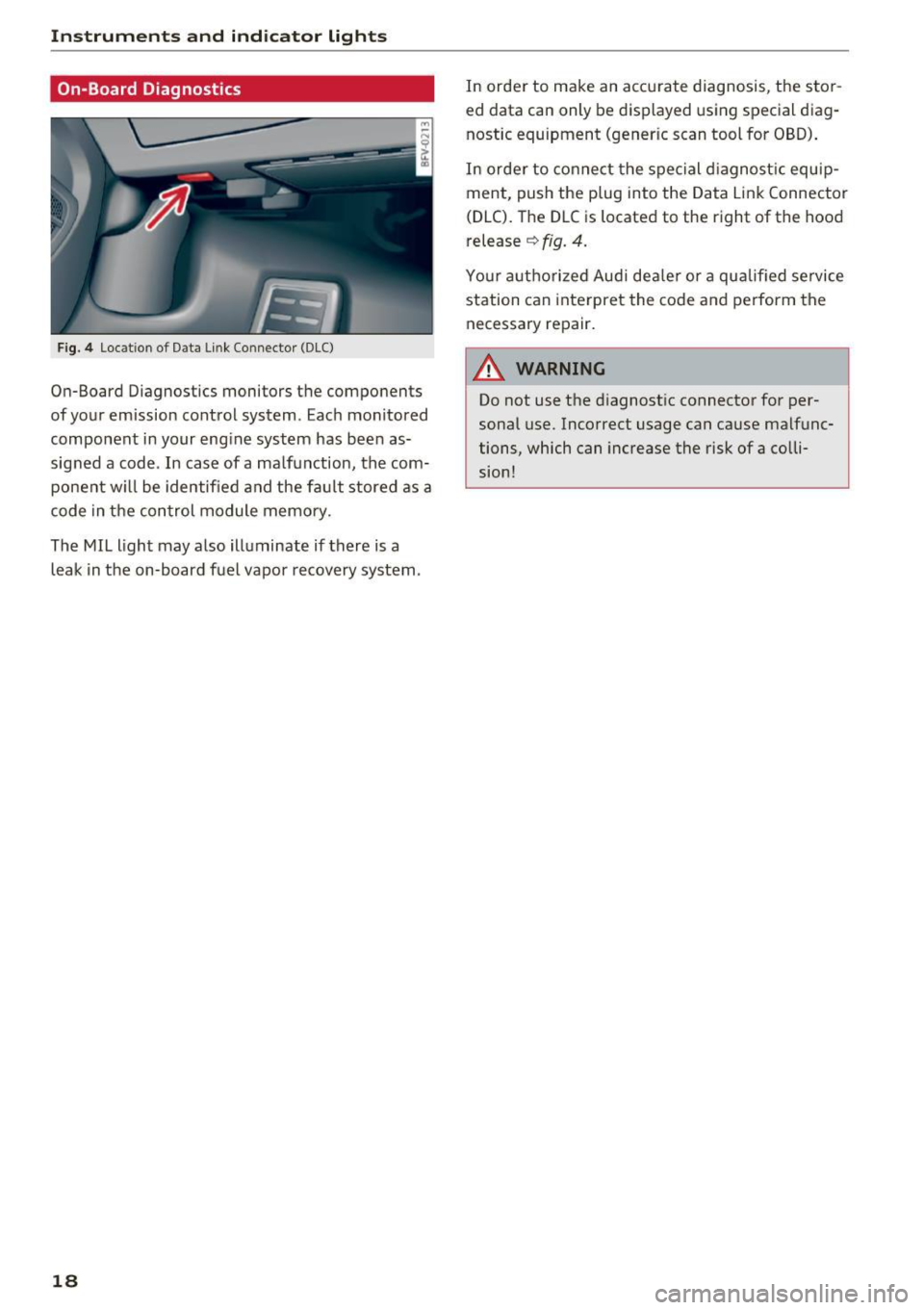
Instrumen ts and ind icator ligh ts
On-Board Diagnostics
F ig. 4 Loc ation of D ata Link Connector (OLC)
On-Board Diagnostics monitors the components
of your emission control system. Eac h monitored
component in your engine system has been as
signed a code . In case of a ma lfunction, the com
ponent w ill be identified and the fa ult stored as a
code in the control module memory.
The MIL light may also ill uminate if there is a
leak in the on-board fuel vapor recovery system .
18
In order to make an accurate diagnosis, the stor
ed data can only b e display ed using special diag
nostic equipment (gener ic scan tool for OBD) .
In order to connect the special d iagnost ic equip
ment, push the plug into the Data Link Connector
(DLC). The DLC is located to the right of the hood
release
~ fig. 4.
Your a utho rized Aud i dea ler or a qua lified service
station can interpret the code and perform the
necessary repair.
A WARNING
Do not use t he diagnostic connector for per
sonal use. Incorrect usage can cause malfunc
tions, which can increase the risk of a co lli
sion!
-
Page 25 of 322
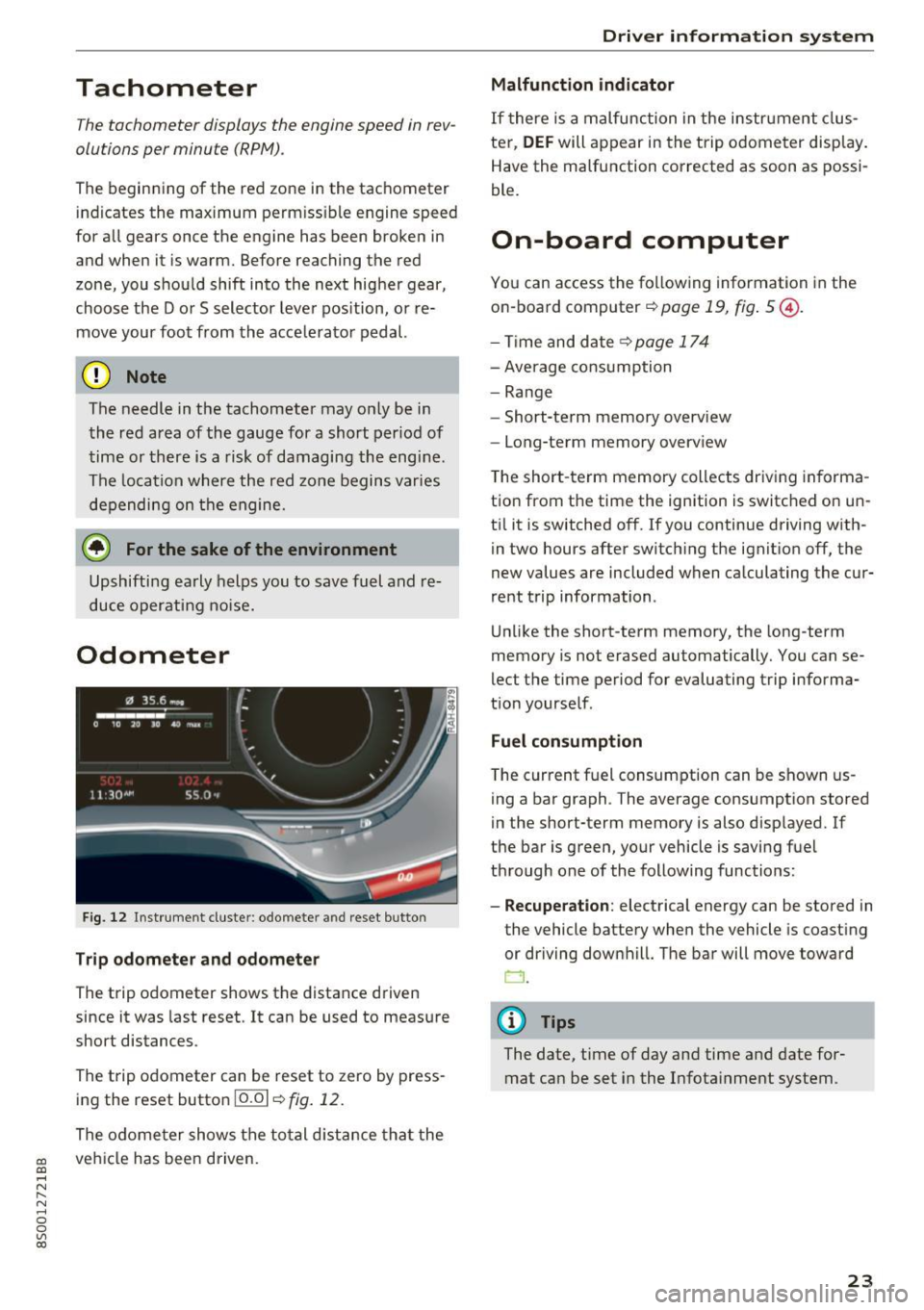
CD
CD
.... N
" N .... 0
0
Ill co
Tachometer
The tachometer displays the engine speed in rev
olutions per minute (RPM) .
The beginning of the red zone in the tachometer
indicates the maximum permissible engine speed
for all gears once the engine has been broken in
and when it is warm. Before reaching the red
zone, you should shift into the next higher gear,
choose the Dor S selector lever position, or re
move your foot from the accelerator pedal.
@ Note
The needle in the tachometer may only be in
the red area of the gauge for a short per iod of
time or there is a risk of damaging the engine .
The location where the red zone begins varies
depending on the engine.
@) For the sake of the environment
Upshifting early helps you to save fuel and re
duce operating noise.
Odometer
Fig. 12 Instrument cluste r: odomete r and reset button
Trip odometer and odometer
The trip odometer shows the distance driven
since it was last reset . It can be used to measure
short distances .
The trip odometer can be reset to zero by press ing the reset button 10.01
r=> fig. 12.
The odometer shows the total d istance that the
veh icle has been driven.
Driver in forma tion system
Malfunction indicator
If there is a malfunction in the instrument clus
ter,
DEF will appear in the trip odometer disp lay.
Have the malfunction corrected as soon as possi
ble.
On-board computer
You can access the following information in the
on-board computer
r=> page 19, fig . 5 @ .
-Time and date ~page 174
-Average consumption
-Range
- Short-term memory overv iew
- Long-term memory overview
The short -term memory collects driving informa
tion from the time the ignition is switched on un
til it is switched off. If you continue driving with·
in two hours after switching the ignition off, the
new values are included when calculating the cur
rent trip information .
Unlike the short-term memory, the long-term
memory is not erased automatically. You can se
lect the time period for evaluating trip informa
tion yourself .
Fuel consumption
The current fuel consumption can be shown us
ing a bar graph . The average consumption stored
in the short-term memory is also displayed. If
the bar is green, your vehicle is saving fuel
through one of the following functions:
- Recuperation : electrical energy can be stored in
the vehicle battery when the vehicle is coasting or driving downhill. The bar will move toward
CJ .
(D Tips
The date, time of day and time and date for
mat can be set in the Infotainment system.
23
Page 53 of 322
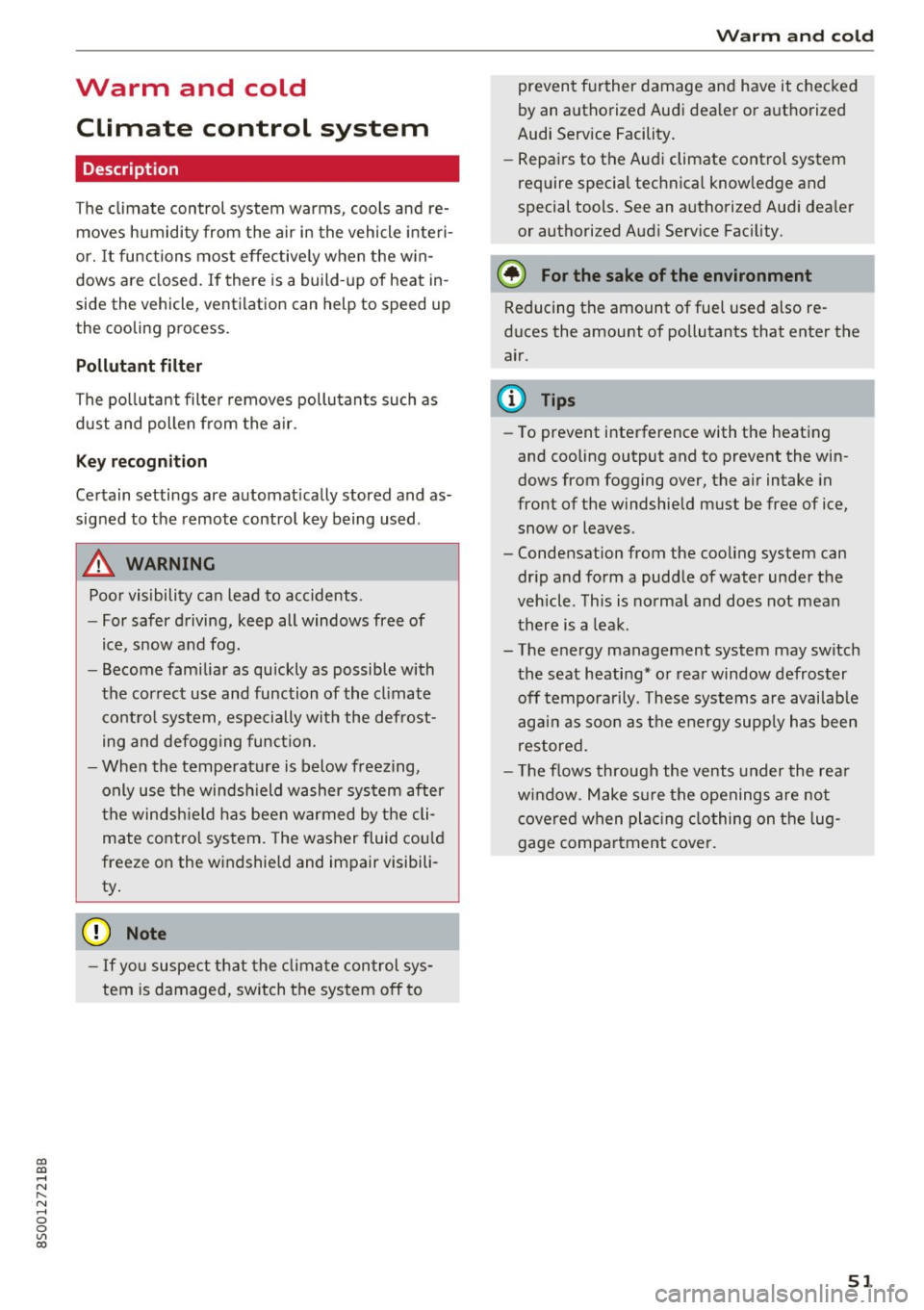
co
co
.... N
" N .... 0
0
Vl c:o
Warm and cold Climate control system
Description
The climate control system warms, cools and re
moves humidity from the air in the vehicle interi
or. It functions most effectively when the w in
dows are closed. If there is a build-up of heat in
side the vehicle, ventilation can help to speed up
the cooling process.
Pollutant filter
The pollutant filter removes pollutants such as
dust and pollen from the air.
Key recognition
Certain settings are automatically stored and as
signed to the remote contro l key being used .
A WARNING
Poor visibility can lead to accidents.
- For safer driving, keep all windows free of
ice, snow and fog.
- Become familiar as quickly as possible with
the correct use and function of the climate
control system, especially with the defrost
ing and defogging function.
- When the temperature is below freezing,
only use the windshield washer system after
the windsh ield has been warmed by the cli
mate control system. The washer fluid could
freeze on the windshield and impair visibili
ty .
(D Note
-If you suspect that the climate control sys
tem is damaged, switch the system off to
Warm and cold
prevent further damage and have it checked
by an authorized Audi dea ler or authorized
Audi Service Facility.
- Repairs to the Audi climate control system
require special technical know ledge and
special tools. See an authorized Audi dealer
or authorized Audi Service Facility.
(® For the sake of the environment
Reducing the amount of fuel used also re
duces the amount of pollutants that enter the
air.
(D Tips
- To prevent interference with the heating
and cooling output and to prevent the win
dows from fogging over, the air intake in
front of the windshield must be free of ice,
snow or leaves.
- Condensation from the cooling system can
drip and form a puddle of water under the
vehicle. This is normal and does not mean
there is a leak .
- The energy management system may switch
the seat heating* or rear window defroster
off temporarily . These systems are availab le
aga in as soon as the energy supp ly has been
restored.
- The flows through the vents under the rear
w indow . Make s ure the openings are not
covered when plac ing clothing on the lug
gage compartment cover .
51
Page 57 of 322
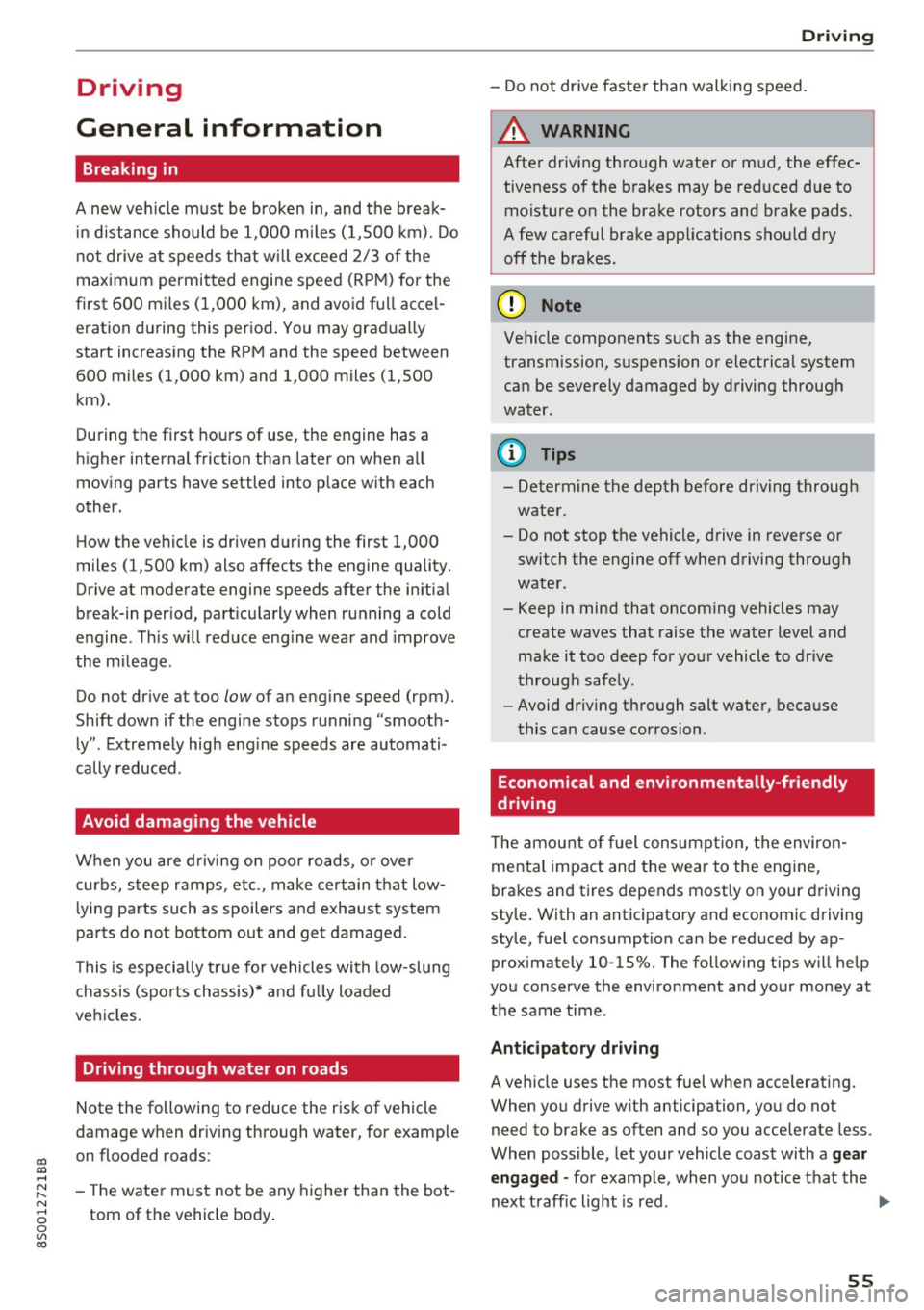
co
co
.... N
" N .... 0
0
Vl c:o
Driving
General information
Breaking in
A new vehicle must be broken in, and the break
in distance should be 1,000 mi les ( 1,500 km). Do
not drive at speeds that w ill exceed
2/3 of the
maximum permitted engine speed
(RPM) for the
first 600 miles (1,000 km) , and avoid full accel
eration during this period . You may gradually
start increasing the
RPM and the speed between
600 miles (1,000 km) and 1,000 miles (1,500
km).
During the first hours of use, the engine has a
higher internal friction than later on when all
moving parts have settled into place with each
other.
How the vehicle is driven during the first 1,000
miles (1,500 km) also affects the engine quality.
Drive at moderate engine speeds after the initial
break-in per iod, part icularly when running a cold
engine . This will reduce engine wear and improve
the mileage .
Do not drive at too low of an engine speed (rpm).
Shift down if the engine stops running "smooth
ly" . Extremely high eng ine speeds are automati
cally reduced .
Avoid damaging the vehicle
When you are driving on poor roads, or over
curbs, steep ramps, etc., make certain that low
lying parts such as spoilers and exhaust system
parts do not bottom out and get damaged.
This is especially true for vehicles with low-slung
chassis (sports chassis)* and fully loaded
vehicles.
Driving through water on roads
Note the following to reduce the risk of vehicle
damage when driving through water, for examp le
on flooded roads :
- The wate r must not be any higher than the bot
tom of the vehicle body .
Driving
- Do not drive faster than walking speed.
A WARNING
After driv ing through water or mud, the effec
tiveness of the brakes may be reduced due to moisture on the brake rotors and brake pads.
A few careful brake applications should dry
off the brakes .
(D Note
Vehicle components such as the engine,
transmission, suspension or electrical system
can be severely damaged by driving through
water.
(D Tips
- Determine the depth before driving through
water.
- Do not stop the vehicle, drive in reverse or
switch the engine off when driving through
water.
- Keep in mind that oncoming vehicles may create waves that raise the water level and
make it too deep for your vehicle to drive
through safely.
- Avoid dr iving through salt water, because
this can cause corrosion.
Economical and environmentally-friendly
driving
T he amount of fuel consumpt ion, the environ
menta l impact and the wear to the engine,
brakes and tires depends mostly on your driving
style. With an anticipatory and economic driving
style, fuel consumption can be reduced by ap
proximately 10-15%. The following tips will help
you conserve the environment and your money at
the same time .
Anticipatory driving
A vehicle uses the most fuel when accelerating.
When you drive with anticipation, you do not
need to brake as often and so you accelerate less.
When possible, let your vehicle coast with a
gear
engaged -
for example, when you notice that the
next traff ic light is red . .,,.
55
Page 58 of 322

Driving
Avoid full acc ele ra tion
You sho uld rare ly travel at the maximum vehicle
speed . High speeds cause a disp roportionately
high increase in fuel consumption, emissions and
traffic noise . Slower driving saves fuel.
Reduce idling time
It pays off to stop the engi ne, for examp le when
at rai lro ad crossings or tr affic lights with longer
red lights . Stopping the engine for 30 -40 sec
onds already saves more fuel than the amount of
extra fuel needed to resta rt the engine.
It t akes a very long time in idle to wa rm the en
g ine up to operating tempe ra ture . Wear and
emissions are especially high in the warm-up
p hase . Therefore, yo u should begin driving im
mediately after starting the engine. Avoid high
RPMs while do ing th is.
Have ma intenanc e performed r egularly
By having maintenance performed regular ly on
your vehicle, yo u can help to reduce f uel con
sumpt ion before you even start to dr ive. The
maintenance condition of your vehicle not only
affects traffic safety and long-term value but a l
so impacts
fuel consumpt ion .
A poorly maintained engine can lead to fuel con
sumpt ion that is 10% higher than normal.
A lso check the
oil le vel when refueling . The o il
consumption
depends large ly on the engine load
and speed. It is normal for the oil consumpt ion
of a new eng ine to reach its lowest point only af
ter a certain amount of use. Therefore, the oil
consumption can o nly be properly judged after
approx imately 3,000 m i (S,000 km) have been
d riven.
Avoid short trips
The engine and exhaust cleaning system must
reach the ir opt imal
operating temperature to ef
fectively red uce consumption and em iss ions.
A co ld engine uses a disproportionately h igh
amount of fuel. The engine reaches operating
temperature and consumpt io n normalizes only
afte r approximately
four kilometers.
56
(D Note
Do not leave engine idling unattended after
starting. If warning lights sho uld come on to
i ndicate imprope r operation, they would go
unheeded. Extended idling also produces
h eat, which could result in overheating or
other damage to the vehicle o r other proper
ty.
(D Note
- Have your ve hicle ma intained properly and
in accordance with the service recommenda
t ions i n your Warranty
& M aintenance book
let. La ck of prope r mai nte na nce as we ll as
imp roper use o f the ve hicle will impa ir the
func tion of the emission cont ro l sys tem and
cou ld lead to damage.
- Do not alte r or remove any compone nt of
the Emission Contro l System unless ap
proved by the man ufacturer.
- Do not alte r or remove any dev ice, such as
heat shields, switches, ig nition w ires,
valves, which are designed to protect your
vehicle's Emission Contro l System and other
important veh icle components.
(D Tips
The cons umption estimates as publishe d by
ENVIRONMENTAL PROTECTION AGENCY
(EPA) and Transport Canada may not corre
spond to your actual consumption on the r oad, which wi ll vary depending upon vehicle
l oad and speed, road a nd wea ther conditions,
tr ip length, etc.